Nvidia RTX 3070 Ti Review
A great graphics card for 1440p gaming
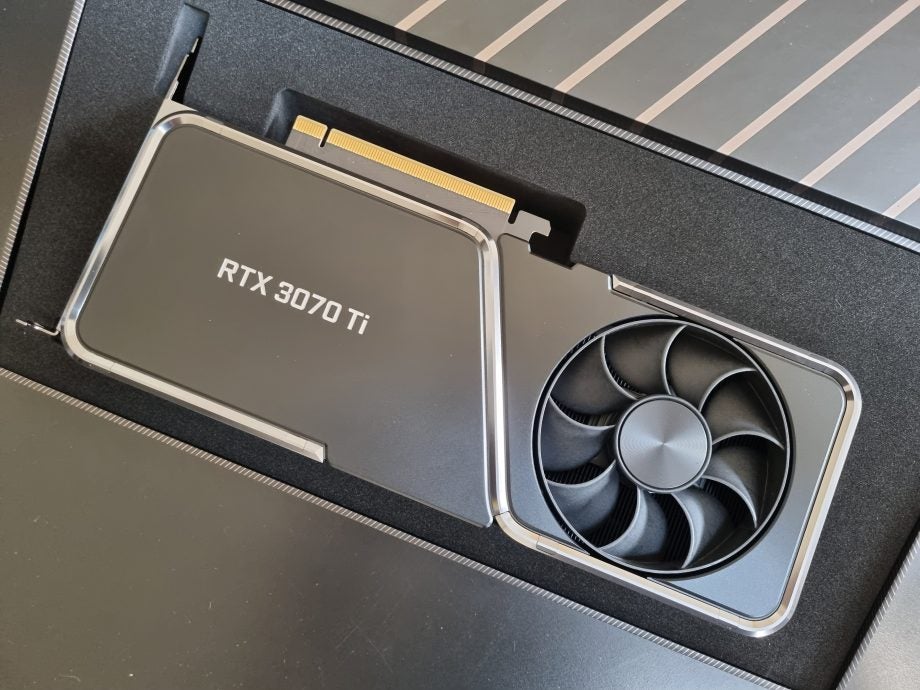

Verdict
The Nvidia RTX 3070 Ti is an excellent graphics card that offers buyers future-proof specs and excellent performance in 1440p and 1080p. If you can get your hands on one, we thoroughly recommend you grab one. However, for 4K gamers that want to enjoy ray tracing graphics, the RTX 3080 family remains the lowest entry point.
Pros
- Top-end 1440p and 1080p ray tracing performance
- DLSS support boosts performance for compatible games
- Future-proof hardware and performance for at least the next 3-5 years
Cons
- Sits in an awkward point between the RTX 3070 and RTX 3080 on price and performance
Availability
- UKRRP: £529
- USARRP: $599
Key Features
- Next-generation specs:The RTX 3070 Ti features all the specs you need to enjoy next generation games, with highlights including DLSS, ray tracing and the use of GDDR6x memory.
- Future-proof connectivity:The inclusion of HDMI 2.1 connectivity means you’ll be able to make the most out of the card if you have a top-end, compatible gaming monitor or TV.
Introduction
The Nvidia RTX 3070 Ti is the latest mid-range graphics card from PC gaming heavyweight Nvidia to hit the market. It’s designed for gamers who want next-generation features, such as ray tracing and DLSS, but don’t have a spare grand lying around to invest in one of Nvidia’s top-end RTX 3080, RTX 3080 Ti or RTX 3090 cards.
Like all Ti cards, it’s a refinement, rather than a next-generation upgrade of Nvidia’s current-generation RTX 3070, which is one of the best GPUs on the market and the only 30-series card to get a perfect score when I tested it last year. The biggest changes are slight upgrades to its core specifications and a jump to more premium GDDR6x VRAM, which should improve key tasks such as data transfer speeds.
This doesn’t make it quite as exciting as the original RTX 3070, which proved to be one of the biggest generational leaps I’ve seen in my career and remains the best graphics card for most buyers. But, after thoroughly benchmarking the unit in Trusted Labs’ test rig, I can confirm it’s a very capable card and an ideal choice for any gamer who can’t afford, or doesn’t need, a top-end RTX 3080 Ti or baseline RTX 3080.
Specs and design
- Built on the same Ampere architecture as other 30-series GPUs
- Both ray tracing and DLSS are supported
- The biggest upgrades is the move to GDDR6X VRAM
Physically, the Nvidia RTX 3070 Ti is near-identical to all the other middle to top-end 30-series graphics cards I’ve tested. It has the same “flow through” cooling system as the RTX 3080, 3080 Ti and 3090, featuring fans positioned at the top and bottom sides of the card on opposing edges. The reference design aims to improve thermals by placing the fans on either side of the heatsink, improving airflow and cooling as a result.
It also uses the same proprietary 12-pin PCIe connector, which means most builders will need to connect it to their PSU (power supply) using an included adapter.
Round the back you’ll also find an identical port setup featuring three display ports and a single HDMI 2.1 input. The latter is important: this is the port you’ll need to play games in 4K at 120Hz. Although, to do this, you’ll also need a compatible gaming monitor or TV. Check out our best gaming monitors and best gaming TV guides if you’re planning on picking one up alongside your GPU.
Under the hood, the RTX 3070 Ti also runs the same Ampere architecture as the other cards. We’ve detailed the positives of Ampere before, but in short, it’s one of the biggest generational leaps we’ve seen in consumer GPU architectures since Nvidia’s 10-series Pascal cards hit the scene many moons ago.
The tech brings with it next-generation ray tracing and DLSS technologies, plus a load of cool extras such as Nvidia’s Reflex low latency tech.

Ray tracing is a demanding new technology that lets GPUs render near-photorealistic lighting effects, including real-time shadows and reflections. The only downside is that it’s super-demanding – so, in my experience, turning it on will see frame rates nose-dive. DLSS is a complementary technology that uses AI wizardry to let the GPU predict, and prepare, what it needs to do next, thus mitigating the effect ray tracing has on frame rates.
These features don’t sound terribly exciting when described in words – but, trust me when I say, once you experience ray tracing you’ll struggle to go back. Games that support the tech look stunning, providing a level of detail that you’ll greatly miss when reverting back to older hardware.
This is especially true of 30-series cards that run ray tracing with second-generation RT cores and DLSS with third-generation tensor cores. The cores are a generational step up on the older technologies used on the preceding 20-series cards, enabling the 30-series GPUs to offer significantly higher frame rates with ray tracing activated.
However, such features are available with all of Nvidia’s latest graphics cards. The only thing that makes the RTX 3070 Ti stand out against its $100/£100 cheaper sibling, the RTX 3070, are its slightly improved specs.
For starters, there are minor improvements to the Ti’s core and boost clock speeds. The RTX 3070 Ti also has more CUDA, RT and tensor cores. CUDA cores are the foot soldiers that do the majority of the heavy lifting when rendering graphics.
However, the biggest upgrade is the jump to GDDR6X memory. The card features 8GB of GDDR6X memory, and while this may not appear to be a huge jump on the 8GB of GDDR6 seen on the base 3070, it’s a key justification for the card’s higher price.
GDDR6X is a higher end, more expensive form of memory that improves data transfer speeds and bandwidth. Every card I’ve tested with GDDR6X has offered superior performance to the equivalents with the base GDDR6 standard. It’s also a key reason that Nvidia is quoting “roughly 10%” performance gains over the 3070 for the new Ti.
You can see a breakdown of how the 3070 Ti’s specs compare to the competition in the table below:
| Card | Price | VRAM | Core clock speed | Boost clock speed | Tensor Cores | RT Cores | RDNA Compute Units | TGP |
| Nvidia RTX 3090 | $1499 | 24GB GDDR6x | 1395 MHz | 1695 MHz | 328 | 82 | NA | 350W |
| Nvidia RTX 3080 Ti | $1199 | 12GB GDDR6x | 1365 MHz | 1665 MHz | 320 | 80 | NA | 350W |
| AMD RX6900 XT | $999 | 16GB GDDR6 | 1825 MHz | 2250 MHz | NA | NA | 80 | 300W |
| Nvidia RTX 3080 | $699 | 10GB GDDR6x | 1440 MHz | 1710 MHz | 272 | 68 | NA | 320W |
| AMD RX 6800 XT | $649 | 16GB GDDR6 | 1825 MHz | 2250 MHz | NA | NA | 72 | 300W |
| Nvidia RTX 3070 Ti | $599 | 8GB GDDR6x | 1575MHz | 1770MHz | 192 | 48 | NA | 290W |
| Nvidia RTX 3070 | $499 | 8GB GDDR6 | 1500 MHz | 1730 MHz | 184 | 46 | NA | 220W |
| AMD RX 6800 | $579 | 16GB GDDR6 | 1700 MHz | 2105 MHz | NA | NA | 60 | 250W |
| AMD RX 6700 XT | $479 | 12GB GDDR6 | 2424 MHz | 2581 MHz | NA | NA | 40 | 230W |
| Nvidia RTX 3060 Ti | $399 | 8GB GDDR6 | 1410 MHz | 1665 MHz | 152 | 38 | NA | 200W |
Benchmarks and performance
- Offers better performance than the RTX 3070 in most games
- Noticeably more demanding than the RTX 3070 and can run hot
As ever, “should” doesn’t mean a lot when buying a GPU, which is the reason we check these claims by running all GPUs we review through a series of benchmarks and real-world performance tests.
I benchmarked the Nvidia RTX 3070 Ti in a test rig with the specs listed below:
Test rig specs:
- Asus ROG Strix Z370-E Gaming (LGA1151)
- Intel Core i9-9900KF
- 16GB DDR4 RAM
- Samsung SSD 860 EVO 500GB SATA SSD
- Corsair RM750X PSU
- MasterLiquid Pro 280 cooler
Each game and benchmark was run in 1080p, 1440p and 4K resolutions with their graphics settings maxed. On compatible games, we ran the same tests with ray tracing and DLSS on/off.
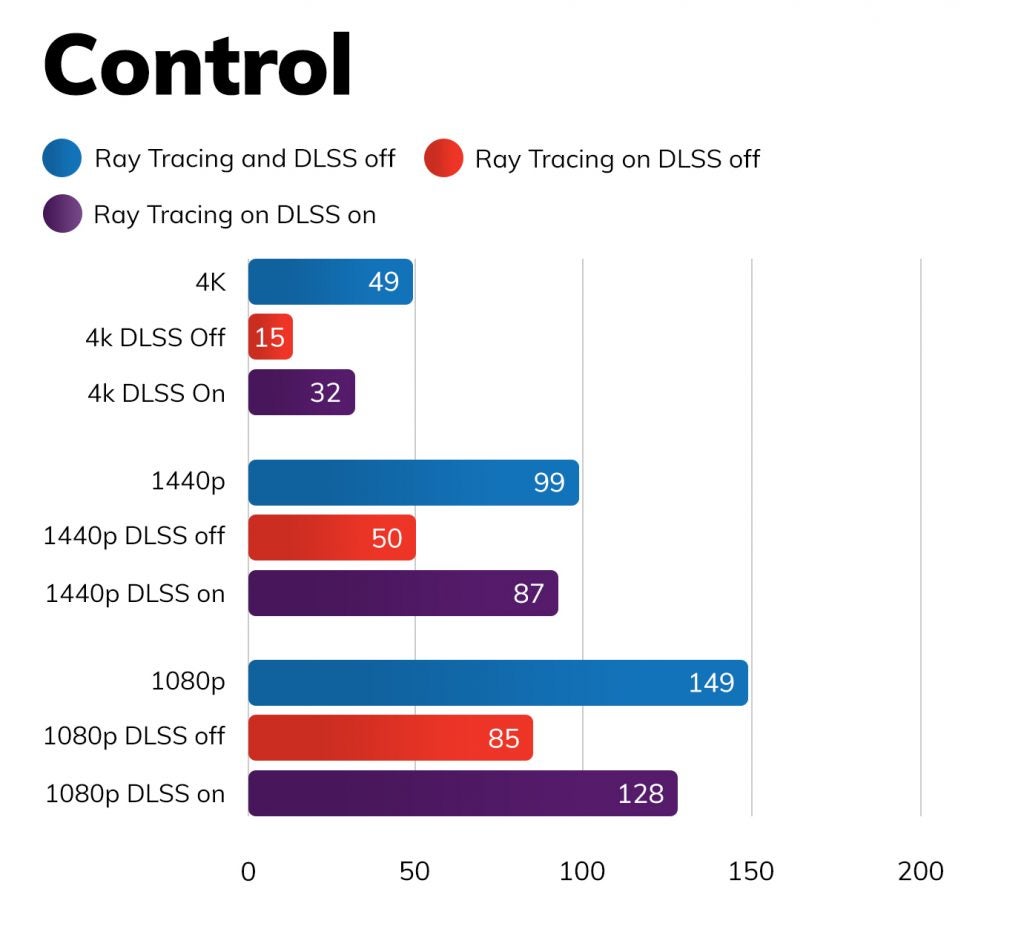
Control
Control is one of the first games optimised for Nvidia ray tracing and it remains a gold standard for showing off the tech. It doesn’t have an internal benchmark, so we tested it by recording an average frame rate running through an early section of the game. The game supports DLSS but lets you differentiate between render and game resolution. With ray tracing on, we used the highest render resolution possible. With ray tracing off, we matched the game and render resolutions.
Here, the RTX 3070 Ti managed to play Control at more-than-playable frame rates in every resolution with ray tracing off, only falling slightly short of the hallowed 60fps standard in 4K. The same was true with ray tracing on, although in busier sections, the game would occasionally drop below 30fps in 4K.
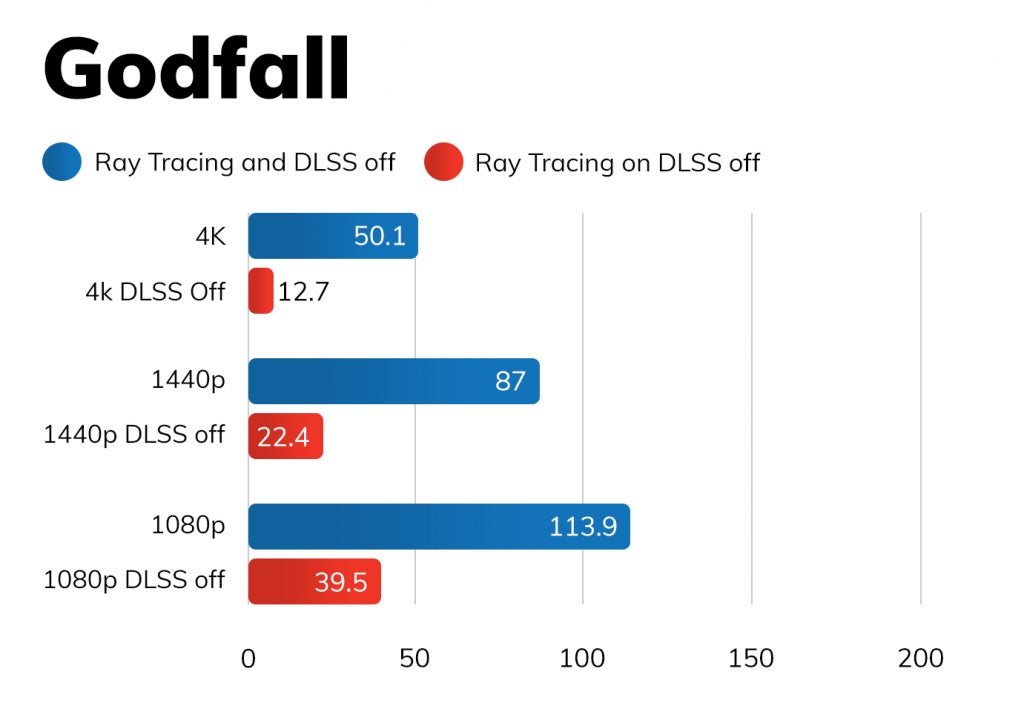
Godfall
Godfall is an AMD-optimised action RPG with ray tracing support. There’s no support for DLSS. In testing the game’s internal benchmark proved temperamental, throwing up atypically low scores, particularly with ray tracing on. These didn’t match the experience I had actually playing the game with the same graphical settings.
The game ran smoothly at all resolutions with ray racing off, only dropping below 60fps in 4K during particularly busy scenes full of hostile enemies. With ray tracing on, 4K performance did occasionally drop below 30fps, but it ran higher than the benchmark’s recorded 12fps consistently. I’m guessing this is a consequence of the pre-release drivers and Godfall’s AMD optimisation.
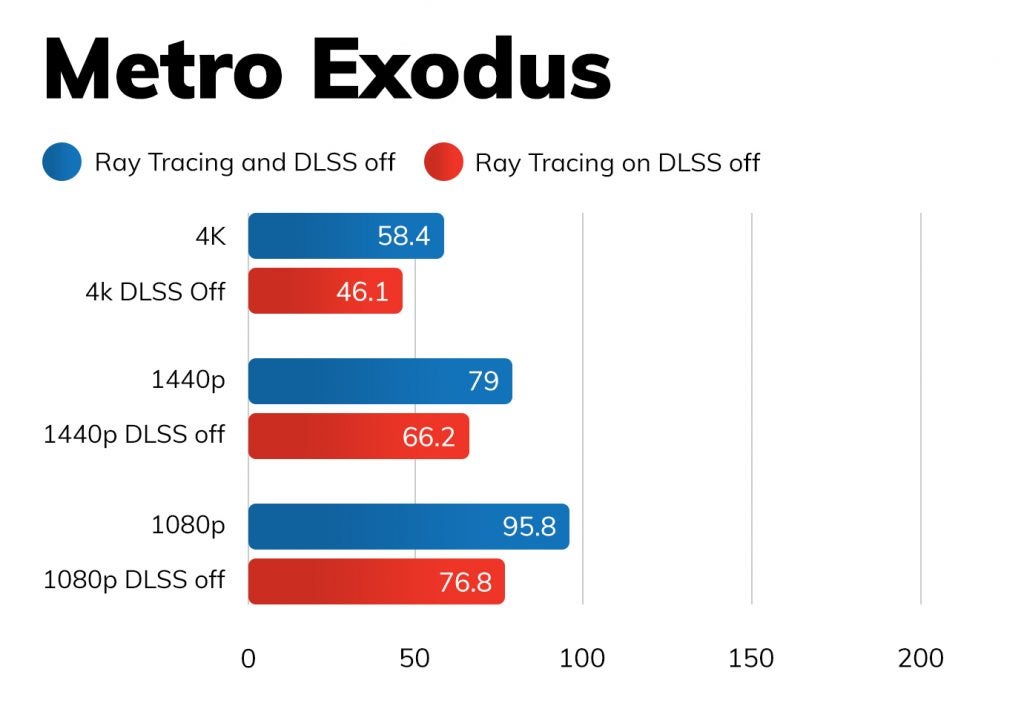
Metro Exodus
Metro Exodus is a AAA first-person shooter set in a sprawling nuclear wasteland. It features ray tracing and DLSS support – although, at the time of publishing, the DLSS feature didn’t work with its internal benchmark.
Even without DLSS, the RTX 3070 Ti powered through the game’s internal benchmark. With ray tracing off, the card ran Metro Exodus smoothly in every resolution. This remained the case with it on, too, with it only dropping significantly below 60fps in 4K.
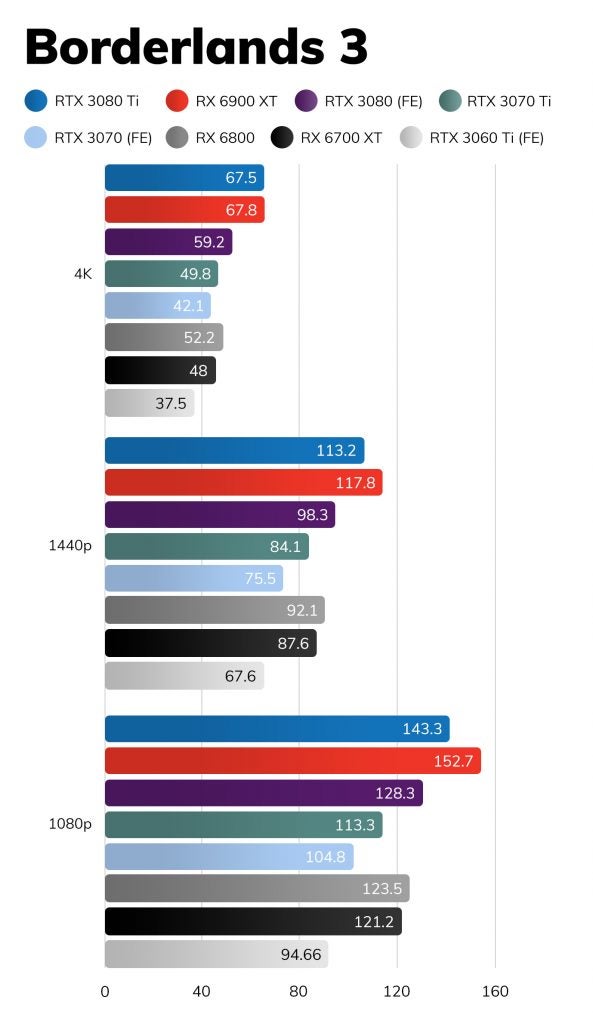
Borderlands 3
Borderlands 3 is a large, open-world, co-op multiplayer first-person shooter. It’s a AAA game with demanding physics, complex textures, and more moving NPCs than can easily be counted. This makes its internal benchmark a great way to gauge how a GPU will run any modern AAA shooter, despite its lack of ray tracing support. Here, again, the RTX 3070 Ti offered post-60fps speeds in everything but 4K. But even here, it only offered a 6-7fps increase on the base 3070.
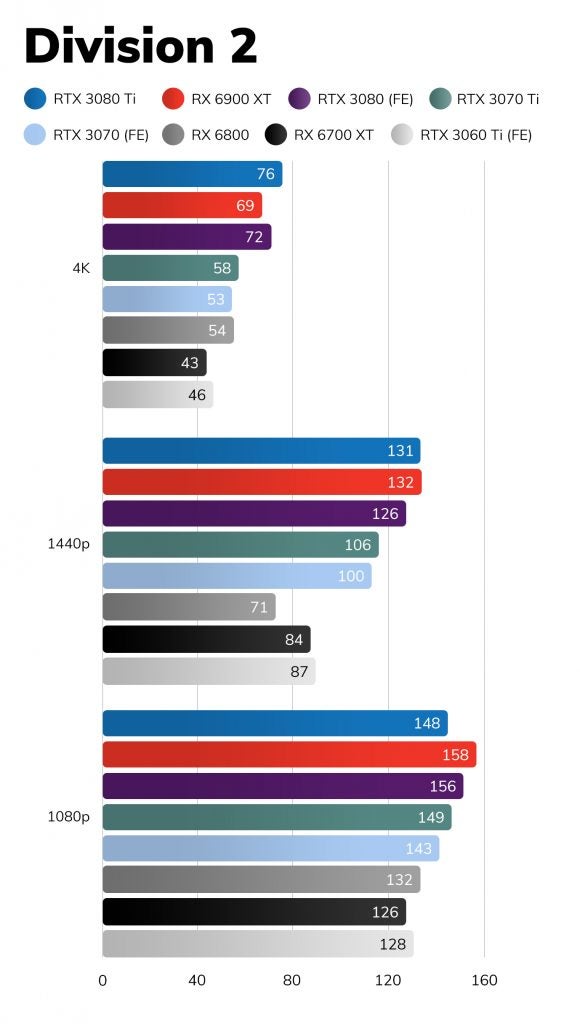
The Division 2
The Division 2 is a live service, multiplayer third-person shooter from gaming heavyweight Ubisoft. It isn’t the most demanding benchmark on our list, but its internal test offers a decent metric to gauge how a GPU will run most live service games. The game is AMD optimised.
Running the internal benchmark, the game ran at consistently excellent frame rates, falling just shy of 60fps in 4K. However, the results were far lower than I expected, and didn’t offer serious performance gains on the base 3070.
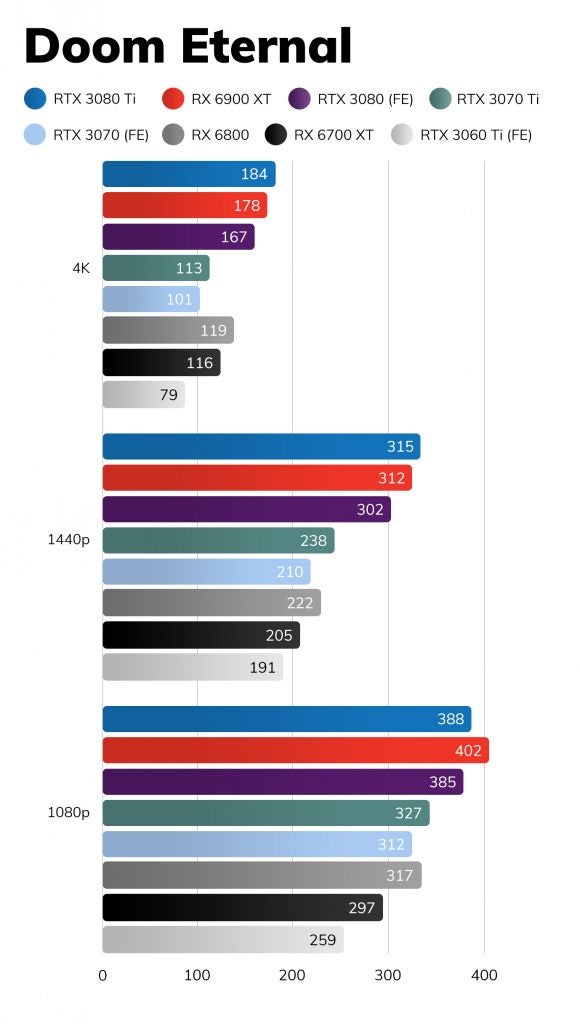
Doom Eternal
Doom Eternal is a modern, wonderfully optimised first-person shooter. It’s also the only game in our current batch of tests that forces you to run it in the Vulkan, rather than Direct X API.
This game doesn’t have an internal benchmark, so we evaluate performance by recording an average frame rate running through a section of the opening level. The game ran blisteringly fast at every resolution, offering over 10fps performance gains on the base 3070.
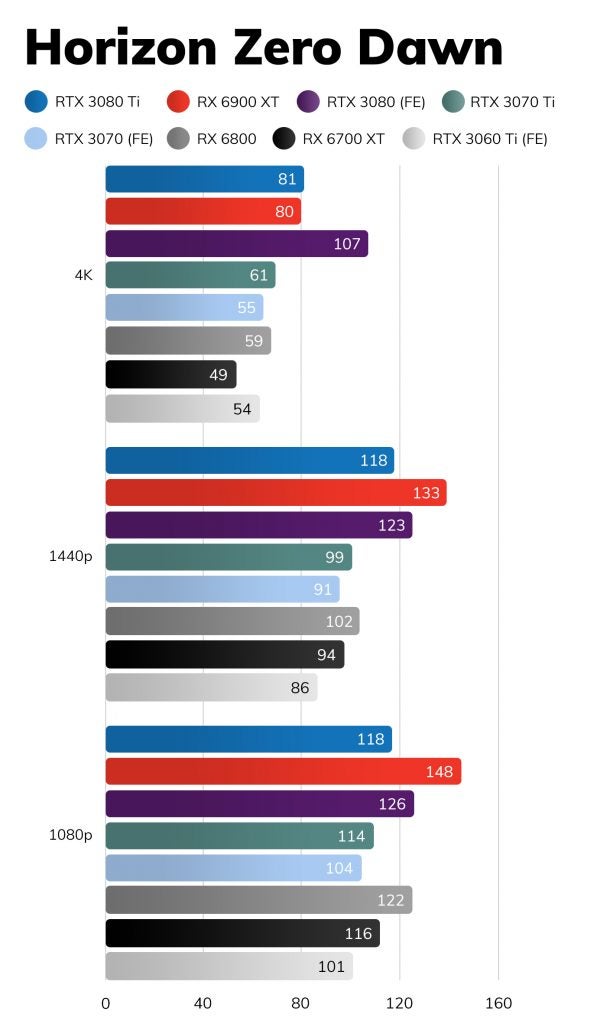
Horizon Zero Dawn
Horizon Zero Dawn is a large-scale AAA title that started life as a PlayStation exclusive. It offers a decent way to judge how a GPU will run demanding titles. Surprisingly, the RTX 3070 Ti ran the game’s internal benchmark at over 60fps in every resolution, offering decent performance gains on the base 3070.
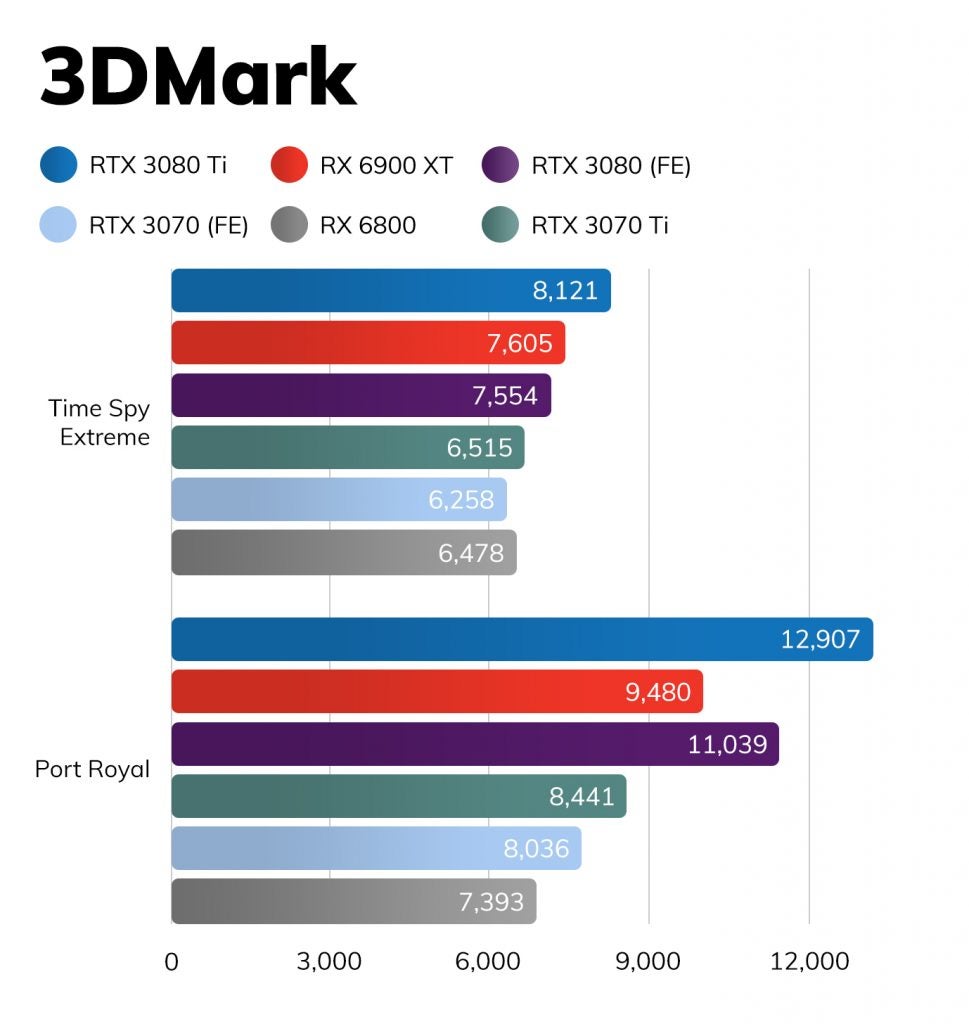
3DMark
3DMark is a suite of synthetic benchmarks designed to offer a holistic view of how a GPU performs in specific areas. The Time Spy Extreme test we use is designed to gauge a card’s Direct X 12 performance.
Port Royal aims to offer an insight into how it handles ray tracing. In both tests, a higher score is better. The 3070 Ti performed as expected, with its scores falling between those of the RTX 3070 and RTX 3080.
Power consumption, thermals and overclocking
Nvidia’s Ti GPUs have a track record for being very demanding cards when it comes to power consumption. And while the 3070 Ti isn’t as power hungry as the RTX 3080 or 3080 Ti, it still requires a lot more power to run than the base 3070.
During testing, I detected a peak 454.1W system drawer running the Time Spy Extreme test. This means you really will want to have at least a 750W PSU running the card, as recommended by Nvidia.
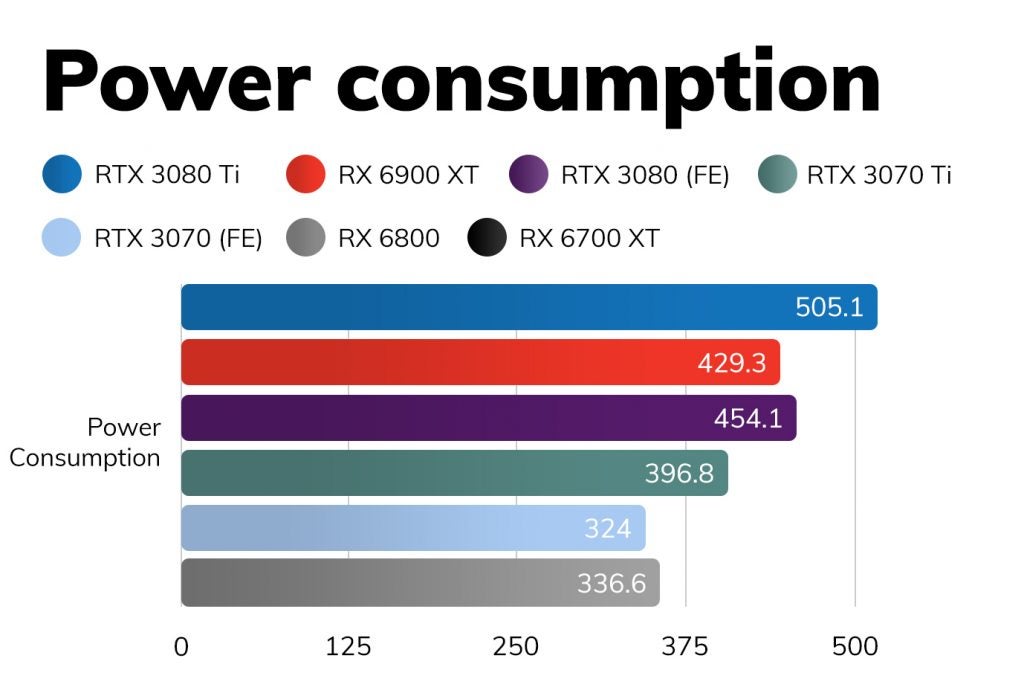
The card also ran hotter than the base 3070, with a peak 87.5ºC operating temperature running the same benchmark. This puts it very close to the 90ºC milestone where instability and performance issues creep in.
None of the 30-series cards are terribly overclockable, and this remains the case on the 3070 Ti. Doing a rough-and-ready overclock using MSI Afterburner while running the Time Spy Extreme stress test I was only able to eke out a 180Hz clock and 120Hz memory increase. This only nets you a few extra frames per second running most games.
Conclusion
The Nvidia RTX 3070 Ti is a very capable card that can easily play modern AAA games up to 1440p with ray tracing on. Considering the lack of GPUs on the market, I’d wholeheartedly recommend any gamer looking for a 1440p performance to grab it the moment they see it.
The only downside is that the card falls into a tricky segment of that market, sitting between the base RTX 3070 and 3080 when it comes to both performance and pricing.
If these cards were in ready supply, I’d recommend buyers stay with the cheaper RTX 3070 if they planned to stick to 1080p or 1440p – it’s cheaper and generally still up to standard at these resolutions. For 4K gamers who want ray tracing, the RTX 3080 remains a better bet since it offers a noticeably better performance in this key area.
Best Offers
Should you buy it?
You’re happy to stick to 1440p gaming:
If you’re after a GPU to play games at 1080p or 1440p with ray tracing activated, then the RTX 3070 Ti is an excellent choice. It blitzed through all our tests, playing nearly every game we threw at it at frame rates above 60fps with their graphics maxed and ray tracing on at these resolutions
You want to play games in 4K with ray tracing: Despite being an excellent performer, the RTX 3070 Ti can’t handle 4K with high frame rates. If you want to play games in 4K with next-generation light effects, then the RTX 3080 is arguably the cheapest option on the market.
Verdict
The Nvidia RTX 3070 Ti is an excellent graphics card that offers buyers future-proof specs and excellent performance in 1440p and 1080p. If you can get your hands on one we thoroughly recommend you grab one. However, for 4K gamers that want to enjoy ray tracing graphics, the RTX 3080 family remains the lowest entry point.
FAQs
The Nvidia RTX 3070 Ti features a single HDMI 2.1 port, that means it can, in theory, run games at 120Hz in 4K.
Like all Nvidia 30-series cards the RTX 3070 Ti does support next-generation ray tracing lighting effects.
The RTX 3070 Ti is a great purchase for any gamer looking to enjoy next generation features, like ray tracing, while playing in 1440p or 1080p resolutions.


